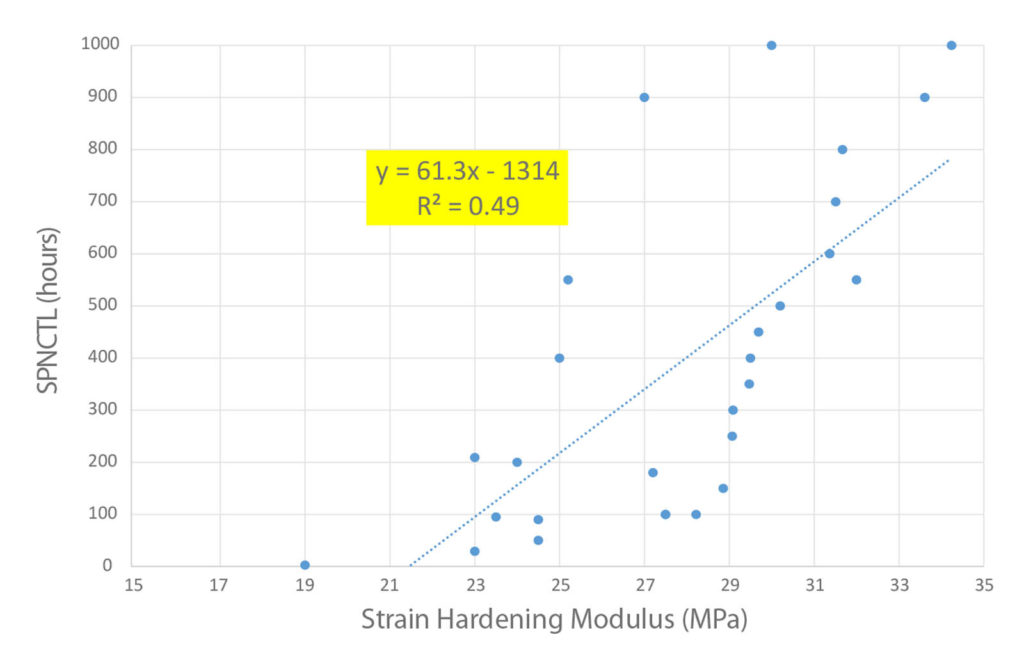Traditionally, high-density polyethylene (HDPE) geomembranes are checked for stress crack resistance using the ASTM D5397 single point-notched constant tensile load (SP-NCTL) test (Hsuan, Lord and Koerner [1990]). This test uses notched specimens, surfactant, and elevated temperatures to accelerate the behavior and force a brittle failure in HDPE geomembranes. With today’s high stress crack resistant HDPE resins, the SP-NCTL test can now take thousands of hours. In short, this is too long for efficient manufacturer quality control. What is needed is an extremely fast method for determining the stress crack susceptibility of HDPE geomembranes. Such a technique has been suggested by Havermans et al. (2010); Zanzinger et al. (2015); and Ramsey, Zanzinger and Zimmel (2018).
Building on the work referenced above and after years of work with two different students, we finally have a new Geosynthetic Institute (GSI) test method for determining the strain hardening modulus of HDPE geomembranes. This method is based on ASTM D6693, “Standard Test Method for Determining Tensile Properties of Nonreinforced Polyethylene and Nonreinforced Flexible Polypropylene Geomembranes” testing protocols, and tries to correlate results to ASTM D5397, “Standard Test Method for Evaluation of Stress Crack Resistance of Polyolefin Geomembranes Using Notched Constant Tension Load Test” findings. The new test method can be used for testing smooth HDPE geomembranes with a thickness between 20 and 200 mil (0.5 and 5 mm).
This test method will facilitate comparison of characteristics of similar materials by standardizing the method for deriving the onset, modulus and break point on the stress-strain curve from an HDPE dog bone tensile test. Strain hardening data can be appropriate for assessing the stress crack susceptibility of HDPE geomembranes. It should be clearly stated that this method shows good correlation between strain hardening modulus and stress crack performance within a specific formulation (resin type plus master batch). In contrast, this method shows very poor correlation between strain hardening modulus and stress crack performance across different formulations. Figure 1 shows a set of data for 27 different HDPE geomembrane formulations, which illustrates this point.

This method has the potential to be yet another statistical process control tool for manufacturers. It will help guarantee the quality of HDPE geomembrane in a timely manner. In addition, this new standard test method will hopefully serve as a platform for improving geomembrane performance. It is interesting to note that IGS-ASTM-GSI Testing Innovation Fellowship Award winner Mahmoud Ali of Queen’s University of Kingston, Ont., Canada, has chosen to shepherd this topic through ASTM Subcommittee D35.02 on Endurance Properties. We also anticipate that this method will be of interest to the International Organization for Standardization (ISO) and that it will eventually be adopted by both organizations for the betterment of our technical community.
References
Havermans-van Beek, D. J. M., Delieck, R., McCarthy, M., Kloth, R., and Kurelec, L. (2010). “An elegant and fast method to predict the slow crack growth behavior of high-density polyethylene pipe materials.” Proc., Plastics Pipes XV Conference, Vancouver, B.C., Canada, 814–25.
Hsuan, Y. H., Lord, Jr., A. E., and Koerner, R. M. (1990). “Ductile-to-brittle transition time in polyethylene geomembrane sheet.” Proc., Geosynthetic Testing for Waste Containment Applications, R. M. Koerner, ed. American Society for Testing and Materials STP1081-EB, West Conshohocken, Pa., 95–109.
Ramsey, B., Zanzinger, H., and Zimmel, E. (2018). “New technique for predictive geomembrane stress crack performance: Commercial application.” Proc., 11th International Conf. on Geosynthetics, Seoul, South Korea, 210–16.
Zanzinger, H., Gerets, B., Wenzel, M., Hausmann, S., and Engelsing, K. (2015). “Determination of the stress cracking resistance of HDPE geomembranes by using accelerated test methods.” Proc., Geosynthetics Conf. 2015, Portland, Ore., 938–44
 TEXTILES.ORG
TEXTILES.ORG


